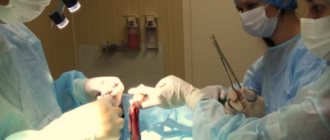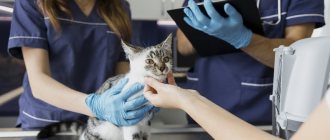Fistula in a cat is a disease with pronounced symptoms, which makes diagnosis easier. And this is very important, because if treatment is not started in a timely manner, sepsis may develop and the animal will die. From this article you will learn what a fistula is, its types, characteristic symptoms, what is the difference between a fistula and an abscess, how to correctly diagnose and treat it.
general information
A fistula (or fistula) is a through channel connecting an internal hollow organ with the external environment (external type) or two cavities between each other (internal type). Its walls can be lined with epithelial or granulation (wound) tissue. In appearance, the fistula may resemble a burst abscess. Therefore, owners who see a wound on their animal decide that they can cope with the disease at home and do not contact the veterinary service, thereby aggravating it.
Only a veterinarian can make the correct diagnosis. And this is very important, because if the fistula is not treated, it can be complicated by sepsis, which will lead to the death of the cat.
Surgery to remove rectal fistula
To better prepare for surgery, your doctor may prescribe antibiotics and topical pain relievers. During the operation to remove a rectal fistula, the following manipulations are performed: excision of the rectal fistula, opening and cleaning of purulent pockets, suturing the sphincter, moving the rectal mucosa to eliminate the internal hole.
1 Surgery to remove rectal fistula
2 Surgery to remove rectal fistula
3 Surgery to remove rectal fistula
The choice of surgical treatment method depends on the type of fistula, its location, the degree of scarring, the presence of ulcers and infiltrates.
Varieties of the disease
Fistulas have several varieties depending on the following factors:
- localization locations;
- the reasons that caused the pathology.
Depending on the location and the fluid released
- Purulent fistulas are a means of draining pus from the source of the inflammatory process located deep inside.
- Urinary fistulas occur on the organs of the genitourinary system (ureter, bladder, urethra). The cause is most often injury.
- Intestinal - affects the upper part of the small intestine and appears as a result of intestinal obstruction, injury or unsuccessful surgery.
- Fistulas in the large intestine are localized in the lower abdomen. They drain feces and occur after injury or surgery.
- Biliary fistulas allow the passage of bile after unsuccessful surgery or as a result of injury. This is a very traumatic type of fistula, since the surrounding tissues are constantly inflamed as a result of contact with its aggressive contents.
- Salivary fluid is the result of inflammatory processes in the area of the roots of the teeth, ears, and cheeks.
Depending on the cause
According to their origin, fistulas are divided into two types:
- congenital (arise as a result of some defects in intrauterine development);
- acquired (arise as a result of injuries, complications after surgery, and various purulent processes).
Congenital fistulas
A congenital fistula is a straight or curved canal, lined from the inside with healthy epithelial tissue, through which there is an outflow of various biological fluids (saliva, urine, feces), depending on which organ is affected.
Presumable causes of the appearance of congenital fistulas are some kind of developmental disorders of the fetus, intrauterine infections when the mother’s immunity decreases while carrying kittens.
Congenital fistulas can be localized on the nose, neck, navel and other places. The most common is the so-called umbilical duct. This is a canal that connects a newborn baby's navel with his abdominal cavity. This type of fistula in itself is not dangerous. But the kitten can get sick, since the canal becomes a gateway for pathological microflora to enter.
Acquired fistulas
An acquired or pathological fistula is a canal lined with hyperemic granulation tissue. It can be the result of injuries (penetrating wounds and open fractures), complications after operations and advanced purulent processes:
- A fistula resulting from a penetrating wound is caused by a deep infected wound.
- A fistula that occurs as a result of tissue damage from bone fragments during treatment of a fracture will gradually close on its own.
- A fistula as a result of a complication of surgical interventions indicates that during the operation or suturing the rules of asepsis and antisepsis were violated, which led to tissue infection and inflammation.
- Advanced purulent processes. Their causes are unsuccessful attempts to cure abscesses or other inflammatory diseases at home. The progression of the process led to a large accumulation of purulent masses seeking outflow.
A dangerous type of fistula in cats is a fecal fistula in the large intestine. It may appear after sterilization or castration of animals carried out in violation. Its contents are feces, which creates a high risk of infection of surrounding tissues and, ultimately, can lead to purulent peritonitis and death.
What it is
In medical terminology, the disease is called a kind of channel that connects the animal’s skin to the body. If you look at it externally, the wound is very similar to an open abscess: a large hole where pus mixed with blood constantly oozes. The smell is the same characteristic as with an abscess.
A cat may develop a disease in the following cases:
- Innately. In this case, the problem arises even during intrauterine development, for example, when the mother had a hole in the navel, which connected the fetus to the abdominal cavity.
- Acquired by way . The disease may appear, for example, after surgery. So, this will indicate that the doctor did not comply with all antiseptic safety measures for the animal. The disease may also appear after improper treatment of the animal by the owners.
This disease does not pose any threat to life, but you should be wary of the fact that dangerous microorganisms can penetrate through the formed channel. Cats in which the disease has occurred near the anus should be under special supervision, since there is a high probability of contracting sepsis and other more serious diseases.
fistula in a cat
The insidiousness of the appearance of the disease lies in the fact that the owners of the animal do not immediately recognize the problem that has arisen. After all, it is very easy to confuse the clinical characteristics of the disease with other inflammatory processes. Especially if the disease appears in the neck area or it is a fistula of the paraanal gland in cats . As a rule, the disease is immediately recognized when the hole reaches a large size.
Fistula and abscess: what is the difference
In appearance, the fistula may resemble a burst abscess (abscess). But there are also differences that the owner must be aware of so as not to confuse these two diseases and not waste time. After all, their treatment should be radically different.
Abscess symptoms
An immature abscess has a dense consistency, the skin on it is tense and hot. After opening, it seems to “deflate”, becoming soft and loose. It has a round hole with smooth edges, from which pus is released after ripening. The opened abscess begins to heal quite quickly.
Symptoms of a fistula
The external fistula has an opening in the form of a deep funnel, sometimes with heavily hyperemic edges. Depending on the location, pus, urine, feces, saliva or bile are released. The fistula does not heal on its own. The owner should be alerted to the fact that liquid is constantly oozing from the wound, and the fur around it is stuck together from the discharge. Another symptom is an unpleasant odor.
An internal fistula is formed after suffering from inflammatory diseases of the internal organs. In the initial stages there are no symptoms, which makes its timely diagnosis difficult. Such fistulas have to be diagnosed at an advanced stage, when treatment may not be successful.
Symptoms of acute proctitis and paraproctitis
Pathologies develop as an acute inflammatory process. Its clinical picture is identical in both cases. This is due to the close proximity of the mucous membrane and fiber of the rectum.
Local symptoms
- constipation/diarrhea;
- fecal incontinence;
- discharge of mucus, pus, and sometimes blood from the anus;
- a feeling of empty bowels and a constant desire to go to the toilet;
- itching and pain around the anus, aggravated by defecation;
- pain on the left side of the abdomen, in the perineum (sometimes radiating to the genitals or lower back).
General symptoms
- weakness;
- headache;
- skin rashes;
- loss of appetite;
- weight loss;
- aches and pain in muscles;
- increase in body temperature to +38…+39 o C, chills.
Diagnosis of the disease
If you suspect that your pet has a fistula, the owner should contact a veterinarian as soon as possible, without waiting for complications. The doctor takes the following diagnostic measures:
- external examination, collection of anamnestic data;
- magnetic resonance or ultrasound examination of the affected area;
- blood chemistry;
- identification of concomitant diseases;
- When the fistula is localized on the back, there is usually a suspicion of a malignant tumor. In this case, a biopsy is prescribed.
Treatment of the disease
Owners who notice a fistula in their cat should know how to treat it. Unfortunately, fistula is a disease that can only be treated surgically. Therapy includes four stages:
- Having reached the source of inflammation, the surgeon eliminates it, simultaneously removing necrotic tissue. This is the most important step, since otherwise the treated fistula will recur. If its top layer is lined with epithelium (congenital type), then healing will not take place without removing the top layer.
- A medical drain is installed near the fistula to direct the outflow of fluid through it, freeing the pathological duct.
- The surgeon then cleans the fistula, removing inflamed tissue, rinses and disinfects it.
- Restorative treatment consists of regular rinsing of the canal, applying a bandage with healing ointments and prescribing antibiotics to prevent complications.
If the fistula exists for quite a long time, then its walls become coarser and can no longer heal on their own. In this case, they are excised and stitched for speedy fusion.
How are pathologies treated?
Despite the similarity of clinical manifestations, proctitis and paraproctitis are treated differently. Treatment of inflammation of the mucous membrane is conservative. If the inflammatory process affects the intestinal tissue, surgical intervention is required.
Conservative therapy
The goal of therapy is to stop the inflammatory process. For this, the patient is prescribed antibiotics (Ceftriaxone, Medaxone) and antimicrobial agents (Biseptol, Bactrim). To rinse the rectum, enemas are done with Collargol, furatsilin solution or warm chamomile infusion. When the symptoms of inflammation decrease, sitz baths in a weak solution of potassium permanganate and oil microenemas are additionally prescribed.
Treatment of proctitis includes diet. The patient is recommended to exclude fatty, spicy, spicy foods, alcohol, and high-fiber foods from the diet. After recovery, he is advised to consume more dietary fiber along with fruits, vegetables and grains to prevent constipation.
Surgical intervention
Paraproctitis requires emergency surgery. It is carried out immediately after diagnosis using general anesthesia. During this procedure, the abscess is opened, its contents are removed, and the cavity is washed with an antiseptic solution.
To prevent relapse and complications, the operated patient is prescribed a course of antibiotics. Wounds are treated daily with antiseptics or antimicrobial agents. In the postoperative period, it is necessary to follow a diet. It prohibits the consumption of foods that cause gas formation and contain large amounts of fiber, spicy and fatty foods.
If symptoms of proctitis and paraproctitis appear, contact your doctor. An experienced proctologist will see you, make an accurate diagnosis and prescribe effective treatment. If necessary, you will receive emergency care immediately after diagnosis.
Prevention measures
Prevention of fistulas involves regular medical examination of animals. After all, a disease noticed in time has every chance of being cured. In case of injury and fractures, care must be taken to ensure that the wounds heal completely and that the fractures heal without complications.
It is necessary to take measures to ensure that the cat’s body resistance is at a high level. This is facilitated by high-quality cat food, enriched with vitamins and microelements, a calm environment, active games, and timely control of parasites. After all, a strong immune system is a reliable protection against many ailments and unpleasant complications.











